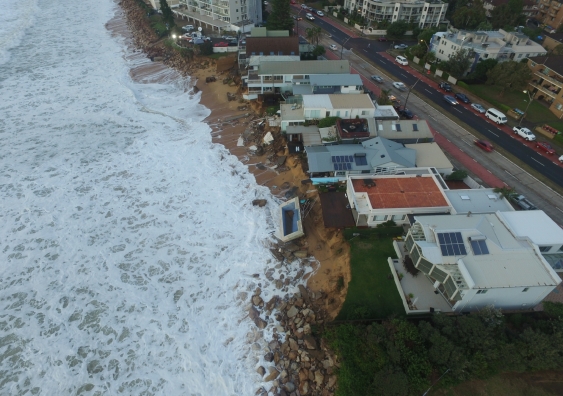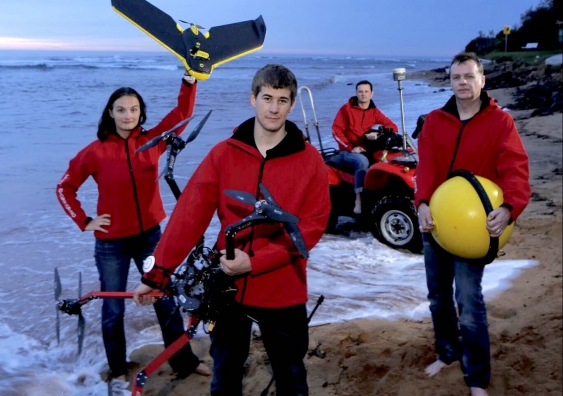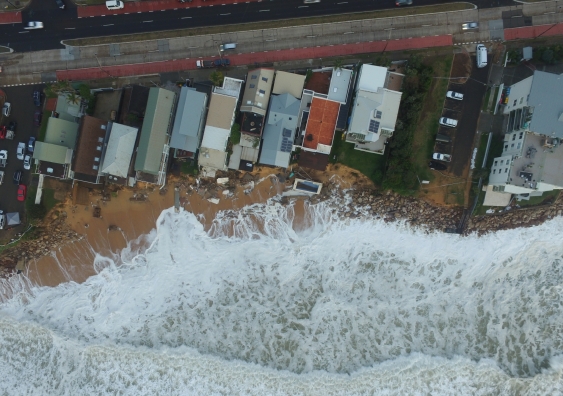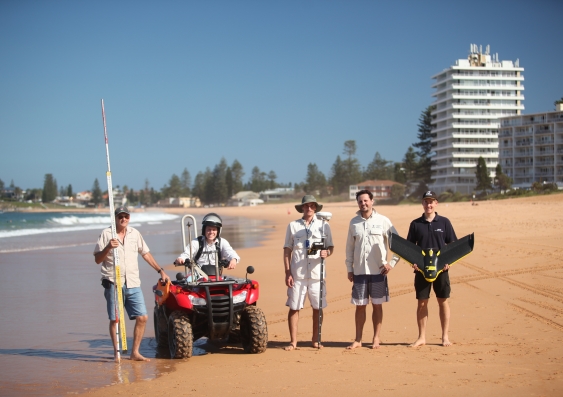Shifting storms to bring extreme waves, damage to once placid areas
The world‚Äôs most extensive study of the impacts of coastal storm fronts in a changing climate has found thatŐżrising seas areŐżno longer the only threat.
The world‚Äôs most extensive study of the impacts of coastal storm fronts in a changing climate has found thatŐżrising seas areŐżno longer the only threat.

The world’s most extensive study of a major storm front striking the coast has revealed a previously unrecognised danger from climate change: as storm patterns fluctuate, waterfront areas once thought safe are likely to be hammered and damaged as never before.
The study, led by engineers at University of New South Wales (UNSW) in Sydney, was published in the latest issue of theŐżjournalŐżNatureŐżScientific Reports.
‚ÄúIf you have waterfront property or infrastructure that has previously been sheltered from the impacts of extreme waves, this is worrying news‚ÄĚ said , lead author and a senior research associate at UNSW‚Äôs (WRL). ‚ÄúWhat this study confirms, is that simply by changing direction, storms can be many times more devastating. And that‚Äôs what we‚Äôre facing in many locations as the climate continues to change.‚ÄĚ
, director of WRL and a co-author, said sea level rise was no longer the only factor at play when preparing for the impact of climate change on waterfront areas. ‚ÄúShifts in storm patterns and wave direction will also have major consequences because they distort and amplify the natural variability of coastal patterns.‚ÄĚ

Dr Mitchell Harley and Prof Ian Turner of the UNSW Water Research Laboratory in Manly Vale, Sydney.
The study relied on data collected during the June 2016 ‚Äėsuperstorm‚Äô that battered eastern Australia. One of the fiercest in decades,Őżit inundated towns, smashed buildings, swept away cars and infrastructure and triggered hundreds of evacuations across a 3,000 km swath from Queensland in the north all the way to Tasmania in the south. Three people died and there were more than 80 rescues from stranded cars.
A week before the storm hit, and for many weeks afterwards, the researchers used a fleet of drones, floating sensor buoys, aircraft fitted with LiDAR laser ranging sensors, fixed cameras on buildings and quad bikes and jet skis fitted with real-time satellite positioning across a 200 km swathe of the eastern seaboard. This produced the largest and most detailed pre- and post-storm coastline analysis ever done.
They found that 11.5 million cubic metres of sand were eroded from beaches across a 200 km stretch of Australia‚Äôs eastern seaboard in just the three days of the storm ‚ÄďŐżthe equivalent of filling the Melbourne Cricket Ground (capacity 100,000 people) to the brim with sand more than seven times.
This was similar to the amount of sand shifted on the USŐżeast coast by Hurricane Sandy in 2012, the largest Atlantic hurricane on record, which killed 233 people and caused US$75 billion in damage.

UNSW’s Water Research Laboratory team with some of their survey gear. Left to right: Kristen Splinter, Christopher Drummond, Mitchell Harley and Ian Turner.
It is the damaging power of wave energy ‚Äď and the disruption of long-established storm patterns due to climate change ‚Äď that present a new danger. The June 2016 ‚Äėsuperstorm‚Äô that devastated Australia‚Äôs east coast was only moderately intense, equivalent to a 1-in-5 year event: however, it did hit from the highly unusual easterly direction.
‚ÄúAnd that‚Äôs what‚Äôs really worrying,‚ÄĚ said Turner. ‚ÄúThe damage we saw from a moderately intense storm last year is a harbinger of what‚Äôs to come,‚ÄĚ said Turner. ‚ÄúClimate change is not only raising the oceans and threatening foreshores but making our coastlines much more vulnerable as the direction of incoming storms change.
‚ÄúWe need to be prepared,‚ÄĚ he added. ‚ÄúNot just for the fact that what we consider as ‚Äėking tides‚Äô will be the norm within decades, but that the storms that strike the coast will come from unexpected directions, damaging coastal areas and infrastructure once thought safe from storm damage.‚ÄĚ
Previous that sea level rise from climate change ‚Äď of between 40 cm and 1 metre over the next century ‚Äď could put $226 billion of infrastructure at risk in Australia alone. This includes road and rail, commercial and residential buildings and even light industrial buildings. But also threatened are 75 hospitals and health centres, 258 police, fire and ambulance stations, five power stations and 41 waste disposal facilities.
‚ÄúWhen it comes to severe weather, a lot of the attention is paid to tropical storms like cyclones and hurricanes,‚ÄĚ said Harley. ‚ÄúBut this data highlights the amount of coastal damage that can occur with east-coast lows in Australia. Despite creating near hurricane-force winds, intense rain and large ocean waves of up to 9 meters, they are less worrisome to many people.‚ÄĚ

The June 2016 ‚Äėsuperstorm‚Äô that battered eastern Australia caused widespread damage to homes and infrastructure, including these homes in Sydney's Collaroy Beach.
Narrabeen Beach in Sydney experienced the most erosion seen in 40 years of monitoringŐż‚ÄďŐżand 36% greater than the second-most erosive event in May 1997. But it was not the worst affected: ‚ÄúAlthough a swimming pool at Narrabeen became the iconic image of the June 2016 storm, the greatest erosion was actually seen at Nine Mile Beach, an unpopulated area just north of Forster,‚ÄĚ added Harley. ‚ÄúAnd that was due to a localised focusing of wave energy.‚ÄĚ
Coupled with a vast bank of data collected over the past 40 years at Narrabeen-Collaroy beaches ‚Äď one of the world‚Äôs longest-running beach erosion monitoring programs ‚Äď coastal engineers now have enough information to build models that can accurately predict the damage storms would do days before an event.
It would also provide a crucial insight into how climate change will interact with the long cycles of El Ni√Īo and La Ni√Īa, and predict coastal vulnerability from sea level rise and changing storm patterns in the decades ahead, said senior lecturer , an engineer and modelling specialist at WRL who deep-dives into the data to build predictive tools.

UNSW Water Research Laboratory engineers with some of their survey equipment.
And not just for Australia, but for the world. ‚ÄúWith this data, we can now construct accurate coastal erosion models, to predict damage days before a storm hits,‚ÄĚ said Splinter. ‚ÄúIt will also be pivotal in understanding the future effect of climate change on coastal variability around the world.‚ÄĚ
Turner agreed: ‚ÄúThis isn‚Äôt just about protecting beaches: billions of dollars‚Äô worth of city infrastructure around the world is threatened by coastal erosion: buildings, roads, power and water utility corridors, sewerage lines ‚Äď and this will only worsen as sea levels rise, causing storm tides to do more damage and reach deeper inland.‚ÄĚ
The WRL team collected the reams of data with the help of staff from the New South Wales Office of Environment and Heritage and worked with UNSW‚Äôs School of Aviation. Other authors were Kristen Splinter, Matthew Phillips and Joshua Simmons from WRL; Michael Kinsela andŐż David Hanslow from the Office of Environment and Heritage; the School of Aviation‚Äôs Jason Middleton and Peter Mumford; and Andrew Short from the University of Sydney.
VIDEO AND STILLS AVAILABLE